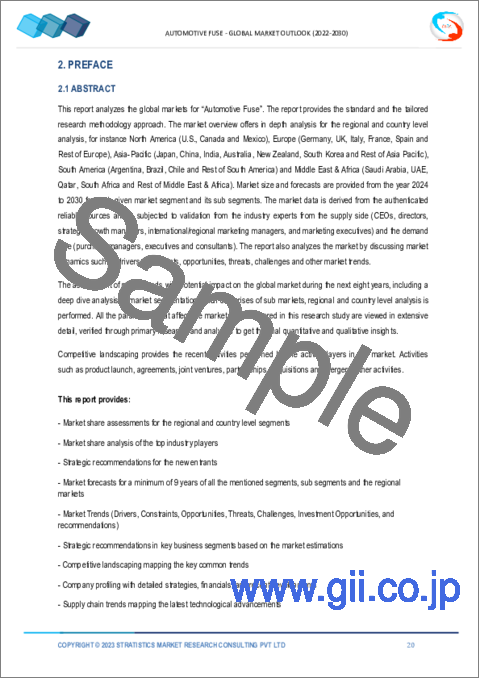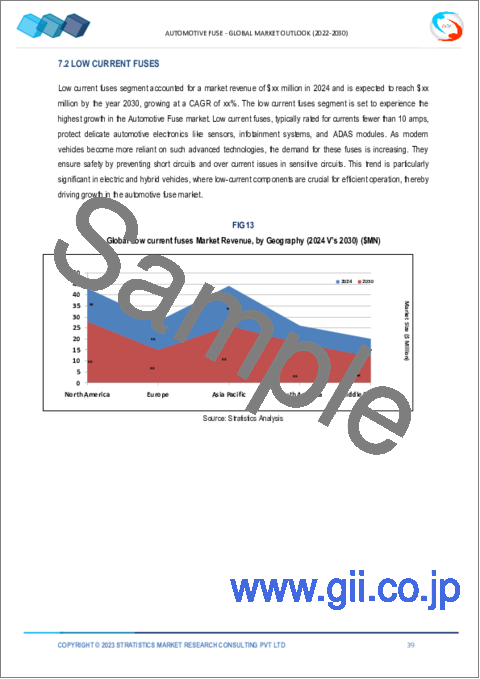|
|
市場調査レポート
商品コード
1551268
自動車用ヒューズ市場の2030年までの予測: タイプ別、車両タイプ別、ヒューズ定格別、用途別、地域別の世界分析Automotive Fuse Market Forecasts to 2030 - Global Analysis By Type (Glass Tube Fuses, Blade Fuses, Cartridge Fuses, Micro Fuses, Mini Fuses, Resettable Fuses, Ceramic Fuses and Other Types), Vehicle Type, Fuse Rating, Application and By Geography |
||||||
カスタマイズ可能
|
|||||||
| 自動車用ヒューズ市場の2030年までの予測: タイプ別、車両タイプ別、ヒューズ定格別、用途別、地域別の世界分析 |
|
出版日: 2024年09月06日
発行: Stratistics Market Research Consulting
ページ情報: 英文 200+ Pages
納期: 2~3営業日
|
- 全表示
- 概要
- 図表
- 目次
Stratistics MRCによると、自動車用ヒューズの世界市場は2024年に277億米ドルを占め、予測期間中のCAGRは4.0%で成長し、2030年には351億米ドルに達する見込みです。
自動車用ヒューズは、自動車の電気回路を過電流による損傷から保護するために設計された電気安全装置です。自動車の電気システムにおいて重要な部品として作動し、部品や配線が潜在的な過負荷や短絡から確実に保護されるようにします。ヒューズは、保護ハウジングに収められた金属ワイヤーまたはフィラメントで構成されています。このワイヤーを流れる電流が規定の定格を超えると、溶けて回路を遮断するように設計されています。
CAAMによると、2022年4月の中国の新エネルギー車販売台数は29万9,000台で、うち28万台が電気乗用車(EV)、1万9,000台が商用EVだった。
車両の電動化と電子コンテンツの増加
安全性、快適性、環境への配慮を背景とした自動車の電動化動向の高まりにより、バッテリー電気自動車(BEV)やハイブリッド電気自動車(HEV)のような充電可能な小型車のヒューズユニット需要が増加しています。バッテリーやモーターなどの高価な部品を電気的サージやショートから保護するために、高度なヒューズ技術が必要とされています。また、自動車用ヒューズ市場は高電圧アーキテクチャへと移行しており、大電流に対応できる特殊なヒューズが必要とされています。
低電圧ヒューズの開発は限定的
現在自動車に搭載されている低電圧ヒューズは、高い故障電流や複雑な電気負荷に対して適切な保護を提供できない可能性があり、電気的故障のリスクが高まり、繊細な部品が損傷する可能性があります。さらに、低電圧ヒューズ技術の進歩が見られないため、自動車業界の進歩が妨げられ、メーカーが進化する自動車の需要や市場競争に対応する妨げになる可能性があります。
プレミアムおよび高級車への需要の高まり
高級車には高度な電子システムが搭載されるようになっており、これらのシステムを電気的障害から保護するため、より多くのヒューズが必要とされています。自動車用ヒューズに対するこのような需要の原動力は、これらの自動車の複雑さと電力要件であり、多くの場合、より高い仕様のヒューズが必要とされるため、メーカーは高度なヒューズ技術の革新と開発に取り組んでいます。
代替技術との競合
スマートジャンクションボックスと統合型サーキットブレーカーの台頭は、従来の自動車用ヒューズの需要を減少させ、特定の用途では自動車用ヒューズに取って代わる可能性があります。その結果、メーカーはこうした代替技術に対抗するため、あるいはそれを下回るために価格を引き下げる必要に迫られ、利益率が低下し、市場の成長を促進する新製品開発への投資が困難になる可能性があります。
COVID-19の影響:
COVID-19の流行は自動車用ヒューズ市場に大きな影響を与え、生産とサプライチェーンの混乱を引き起こしました。操業停止や規制によって工場が閉鎖され、自動車製造が減少した結果、自動車用ヒューズの需要が減少しました。さらに、世界の健康危機はヒューズの生産に不可欠な原材料の供給を妨げ、遅れをさらに悪化させ、コストを増加させました。自動車産業が徐々に回復するにつれ、自動車の電動化と高度な電子システムへのシフトが、特殊ヒューズの需要を将来的に牽引すると予想されます。
予測期間中、ガラス管ヒューズ・セグメントが最大となる見込み
ガラス管ヒューズは、正確な低電流保護のために古い車両に使用されているが、最新のブレードヒューズに比べると優位性が低いため、予測期間中は最大になると予想されます。ガラス管ヒューズはコスト効率が高く信頼性が高いが、高振動環境では堅牢性に劣る。このため、高度なヒューズ技術を搭載した新型車両での使用に影響を与え、特定の市場セグメントの需要に影響を与える可能性があります。
予測期間中、中電流ヒューズ分野のCAGRが最も高くなると予測されます。
自動車の電子部品の増加により、一般的に定格電流が10~30アンペアの中電流ヒューズの需要が増加しているため、中電流ヒューズ分野は予測期間中に最も高いCAGRが見込まれます。これらのヒューズは回路を保護し、電気システムの信頼性と安全性を確保するために極めて重要です。自動車メーカーが安全性と性能の向上に注力する中、中電流ヒューズの採用は増加すると思われます。
最大のシェアを占める地域:
北米は、北米、特に米国とカナダにおける厳格な安全および排ガス規制の影響を大きく受けているため、予測期間中最大の市場シェアを占めると予測されます。これらの規制を遵守するためには、車両の安全性と性能を確保するために信頼性が高く効果的なヒューズ技術を使用する必要があり、この地域の市場成長を後押ししています。
CAGRが最も高い地域:
アジア太平洋地域は予測期間中最も高いCAGRを維持すると予測されます。これは、小型化されたヒューズや耐久性のある材料など、ヒューズ技術の技術的進歩の影響を受けており、最新の自動車の複雑な電気システムの性能と信頼性が向上しているためです。アジア太平洋地域における電気自動車やハイブリッド車の増加により、より高い負荷と信頼性の高い保護に対応した特殊なヒューズが必要とされています。
無料のカスタマイズサービス:
本レポートをご購読のお客様には、以下の無料カスタマイズオプションのいずれかをご利用いただけます:
- 企業プロファイル
- 追加市場プレイヤーの包括的プロファイリング(3社まで)
- 主要企業のSWOT分析(3社まで)
- 地域セグメンテーション
- 顧客の関心に応じた主要国の市場推計・予測・CAGR(注:フィージビリティチェックによる)
- 競合ベンチマーキング
- 製品ポートフォリオ、地理的プレゼンス、戦略的提携に基づく主要企業のベンチマーキング
目次
第1章 エグゼクティブサマリー
第2章 序文
- 概要
- ステークホルダー
- 調査範囲
- 調査手法
- データマイニング
- データ分析
- データ検証
- 調査アプローチ
- 調査情報源
- 1次調査情報源
- 2次調査情報源
- 前提条件
第3章 市場動向分析
- 促進要因
- 抑制要因
- 機会
- 脅威
- 用途分析
- 新興市場
- COVID-19の影響
第4章 ポーターのファイブフォース分析
- 供給企業の交渉力
- 買い手の交渉力
- 代替品の脅威
- 新規参入業者の脅威
- 競争企業間の敵対関係
第5章 世界の自動車用ヒューズ市場:タイプ別
- ガラス管ヒューズ
- ブレードヒューズ
- カートリッジヒューズ
- マイクロヒューズ
- ミニヒューズ
- リセット可能なヒューズ
- セラミックヒューズ
- その他のタイプ
第6章 世界の自動車用ヒューズ市場:車両タイプ別
- 乗用車
- 小型商用車
- 電気自動車(EV)
- 二輪車
- その他の車両タイプ
第7章 世界の自動車用ヒューズ市場:ヒューズ定格別
- 低電流ヒューズ
- 中電流ヒューズ
- 高電流ヒューズ
第8章 世界の自動車用ヒューズ市場:用途別
- パワートレイン
- ボディ
- シャーシ
- セーフティ
- エレクトロニクス
- その他の用途
第9章 世界の自動車用ヒューズ市場:地域別
- 北米
- 米国
- カナダ
- メキシコ
- 欧州
- ドイツ
- 英国
- イタリア
- フランス
- スペイン
- その他欧州
- アジア太平洋
- 日本
- 中国
- インド
- オーストラリア
- ニュージーランド
- 韓国
- その他アジア太平洋地域
- 南米
- アルゼンチン
- ブラジル
- チリ
- その他南米
- 中東・アフリカ
- サウジアラビア
- アラブ首長国連邦
- カタール
- 南アフリカ
- その他中東とアフリカ
第10章 主な発展
- 契約、パートナーシップ、コラボレーション、合弁事業
- 買収と合併
- 新製品発売
- 事業拡大
- その他の主要戦略
第11章 企業プロファイリング
- AEM Components(USA), Inc.
- Bel Fuse Inc.
- Blue Sea Systems
- Eaton Corporation
- E-T-A ElektrotechnischeApparateGmbH
- Fuzetec
- Little Fuse Inc.
- Mersen Electrical Power
- MERSEN S.A
- ON Semiconductor
- OptiFuse
- Pacific Engineering Corporation
- Panduit Corp
- Schurter Holding AG
- Sensata Technologies
List of Tables
- Table 1 Global Automotive Fuse Market Outlook, By Region (2022-2030) ($MN)
- Table 2 Global Automotive Fuse Market Outlook, By Type (2022-2030) ($MN)
- Table 3 Global Automotive Fuse Market Outlook, By Glass Tube Fuses (2022-2030) ($MN)
- Table 4 Global Automotive Fuse Market Outlook, By Blade Fuses (2022-2030) ($MN)
- Table 5 Global Automotive Fuse Market Outlook, By Cartridge Fuses (2022-2030) ($MN)
- Table 6 Global Automotive Fuse Market Outlook, By Micro Fuses (2022-2030) ($MN)
- Table 7 Global Automotive Fuse Market Outlook, By Mini Fuses (2022-2030) ($MN)
- Table 8 Global Automotive Fuse Market Outlook, By Resettable Fuses (2022-2030) ($MN)
- Table 9 Global Automotive Fuse Market Outlook, By Ceramic Fuses (2022-2030) ($MN)
- Table 10 Global Automotive Fuse Market Outlook, By Other Types (2022-2030) ($MN)
- Table 11 Global Automotive Fuse Market Outlook, By Vehicle Type (2022-2030) ($MN)
- Table 12 Global Automotive Fuse Market Outlook, By Passenger Cars (2022-2030) ($MN)
- Table 13 Global Automotive Fuse Market Outlook, By Light Commercial Vehicles (2022-2030) ($MN)
- Table 14 Global Automotive Fuse Market Outlook, By Electric Vehicles (EVs) (2022-2030) ($MN)
- Table 15 Global Automotive Fuse Market Outlook, By Two-Wheelers (2022-2030) ($MN)
- Table 16 Global Automotive Fuse Market Outlook, By Other Vehicle Types (2022-2030) ($MN)
- Table 17 Global Automotive Fuse Market Outlook, By Fuse Rating (2022-2030) ($MN)
- Table 18 Global Automotive Fuse Market Outlook, By Low Current Fuses (2022-2030) ($MN)
- Table 19 Global Automotive Fuse Market Outlook, By Medium Current Fuses (2022-2030) ($MN)
- Table 20 Global Automotive Fuse Market Outlook, By High Current Fuses (2022-2030) ($MN)
- Table 21 Global Automotive Fuse Market Outlook, By Application (2022-2030) ($MN)
- Table 22 Global Automotive Fuse Market Outlook, By Powertrain (2022-2030) ($MN)
- Table 23 Global Automotive Fuse Market Outlook, By Body (2022-2030) ($MN)
- Table 24 Global Automotive Fuse Market Outlook, By Chassis (2022-2030) ($MN)
- Table 25 Global Automotive Fuse Market Outlook, By Safety (2022-2030) ($MN)
- Table 26 Global Automotive Fuse Market Outlook, By Electronics (2022-2030) ($MN)
- Table 27 Global Automotive Fuse Market Outlook, By Other Applications (2022-2030) ($MN)
Note: Tables for North America, Europe, APAC, South America, and Middle East & Africa Regions are also represented in the same manner as above.
According to Stratistics MRC, the Global Automotive Fuse Market is accounted for $27.7 billion in 2024 and is expected to reach $35.1 billion by 2030 growing at a CAGR of 4.0% during the forecast period. Automotive fuse is an electrical safety device designed to protect a vehicle's electrical circuits from damage caused by excessive current. It operates as a critical component in a vehicle's electrical system, ensuring that components and wiring are shielded from potential overloads and short circuits. The fuse consists of a metal wire or filament encased in a protective housing. This wire is designed to melt and break the circuit when the current flowing through it exceeds a specified rating.
According to CAAM, in April 2022, China's new energy vehicle sales amounted to 299,000 units, of which 280,000 were electric passenger vehicles (EVs) and 19,000 were commercial electric vehicles.
Market Dynamics:
Driver:
Increasing vehicle electrification and electronic content
The increasing trend of vehicle electrification, driven by safety, comfort, and environmental concerns, is increasing the demand for fuse units in light-duty chargeable vehicles like battery electric vehicles (BEVs) and hybrid electric vehicles (HEVs). Advanced fuse technology is needed to protect expensive components like batteries and motors from electrical surges or short circuits. The automotive fuse market is also shifting towards high-voltage architectures, which require specialized fuses capable of handling higher currents.
Restraint:
Limited development in low-voltage fuses
The current low-voltage fuses in vehicles may not provide adequate protection against high fault currents and complex electrical loads, leading to increased risks of electrical failures and potential damage to sensitive components. Additionally, the lack of advancements in low-voltage fuse technology can hinder the automotive industry's progress, hindering manufacturers' ability to meet evolving vehicle demands and market competitiveness.
Opportunity:
Growing demand for premium and luxury vehicles
Luxury vehicles are increasingly equipped with advanced electronic systems, requiring a higher number of fuses to protect these systems from electrical faults. This demand for automotive fuses is driven by the complexity and power requirements of these vehicles, which often require fuses with higher specifications, prompting manufacturers to innovate and develop advanced fuse technologies.
Threat:
Competition from alternative technologies
The rise of smart junction boxes and integrated circuit breakers may decrease the demand for traditional automotive fuses, potentially replacing them in certain applications. This could also pressure manufacturers to lower prices to match or undercut these alternatives, resulting in reduced profit margins and making it difficult for them to invest in new product development driving the growth of the market.
Covid-19 Impact:
The COVID-19 pandemic significantly impacted the Automotive Fuse market, causing disruptions in production and supply chains. Lockdowns and restrictions led to factory closures and reduced vehicle manufacturing, resulting in decreased demand for automotive fuses. Additionally, global health crises disrupted the supply of raw materials essential for fuse production, further exacerbating delays and increasing costs. As the automotive industry gradually recovers, the shift towards electrification and advanced electronic systems in vehicles is expected to drive future demand for specialized fuses.
The glass tube fuses segment is expected to be the largest during the forecast period
The glass tube fuses is expected to be the largest during the forecast period as they are used in older vehicles for precise, low-current protection, but are less dominant than modern blade fuses. They are cost-effective and reliable, but less robust in high-vibration environments. This may influence their use in newer vehicles with advanced fuse technologies, affecting demand in specific market segments.
The medium current fuses segment is expected to have the highest CAGR during the forecast period
The medium current fuses segment is expected to have the highest CAGR during the forecast period as the demand for medium current fuses, typically rated between 10 to 30 amps, is increasing due to the rise in electronic components in vehicles. These fuses are crucial for protecting circuits and ensuring the reliability and safety of electrical systems. As automotive manufacturers focus on improving safety and performance, the adoption of medium current fuses is likely to increase.
Region with largest share:
North America is projected to hold the largest market share during the forecast period as the market is significantly influenced by stringent safety and emission regulations in North America, particularly in the United States and Canada. Compliance with these regulations necessitates the use of reliable and effective fuse technologies to ensure vehicle safety and performance propelling the market growth in this region.
Region with highest CAGR:
Asia Pacific is projected to hold the highest CAGR over the forecast period because the market is being influenced by technological advancements in fuse technology, including miniaturized fuses and durable materials, which offer improved performance and reliability for complex electrical systems in modern vehicles. The rise of electric and hybrid vehicles in the Asia-Pacific region necessitates specialized fuses for higher loads and reliable protection.
Key players in the market
Some of the key players in Automotive Fuse market include AEM Components (USA), Inc., Bel Fuse Inc., Blue Sea Systems, Eaton Corporation, E-T-A Elektrotechnische Apparate GmbH, Fuzetec, Little Fuse Inc., Mersen Electrical Power, ON Semiconductor, OptiFuse , Pacific Engineering Corporation, Panduit Corp, Schurter Holding AG and Sensata Technologies
Key Developments:
In April 2024, Eaton's relaunch program enabling women to restart their careers. The program is aimed at women in India who were on a career break due to any significant reason and are now looking to restart their professional journey.
In June 2024, Eaton in India expands its manufacturing footprint in Puducherry. The new block spans an impressive 40,000 square feet and is laid out with cutting-edge manufacturing lines to produce ACBs (Air Circuit Breakers) and MCCBs (Molded Case Circuit Breakers) to ably serve the Electrical Industry deploying the state-of-the-art LEAN manufacturing concepts.
Types Covered:
- Glass Tube Fuses
- Blade Fuses
- Cartridge Fuses
- Micro Fuses
- Mini Fuses
- Resettable Fuses
- Ceramic Fuses
- Other Types
Vehicle Types Covered:
- Passenger Cars
- Light Commercial Vehicles
- Electric Vehicles (EVs)
- Two-Wheelers
- Other Vehicle Types
Fuse Ratings Covered:
- Low Current Fuses
- Medium Current Fuses
- High Current Fuses
Applications Covered:
- Powertrain
- Body
- Chassis
- Safety
- Electronics
- Other Applications
Regions Covered:
- North America
- US
- Canada
- Mexico
- Europe
- Germany
- UK
- Italy
- France
- Spain
- Rest of Europe
- Asia Pacific
- Japan
- China
- India
- Australia
- New Zealand
- South Korea
- Rest of Asia Pacific
- South America
- Argentina
- Brazil
- Chile
- Rest of South America
- Middle East & Africa
- Saudi Arabia
- UAE
- Qatar
- South Africa
- Rest of Middle East & Africa
What our report offers:
- Market share assessments for the regional and country-level segments
- Strategic recommendations for the new entrants
- Covers Market data for the years 2022, 2023, 2024, 2026, and 2030
- Market Trends (Drivers, Constraints, Opportunities, Threats, Challenges, Investment Opportunities, and recommendations)
- Strategic recommendations in key business segments based on the market estimations
- Competitive landscaping mapping the key common trends
- Company profiling with detailed strategies, financials, and recent developments
- Supply chain trends mapping the latest technological advancements
Free Customization Offerings:
All the customers of this report will be entitled to receive one of the following free customization options:
- Company Profiling
- Comprehensive profiling of additional market players (up to 3)
- SWOT Analysis of key players (up to 3)
- Regional Segmentation
- Market estimations, Forecasts and CAGR of any prominent country as per the client's interest (Note: Depends on feasibility check)
- Competitive Benchmarking
- Benchmarking of key players based on product portfolio, geographical presence, and strategic alliances
Table of Contents
1 Executive Summary
2 Preface
- 2.1 Abstract
- 2.2 Stake Holders
- 2.3 Research Scope
- 2.4 Research Methodology
- 2.4.1 Data Mining
- 2.4.2 Data Analysis
- 2.4.3 Data Validation
- 2.4.4 Research Approach
- 2.5 Research Sources
- 2.5.1 Primary Research Sources
- 2.5.2 Secondary Research Sources
- 2.5.3 Assumptions
3 Market Trend Analysis
- 3.1 Introduction
- 3.2 Drivers
- 3.3 Restraints
- 3.4 Opportunities
- 3.5 Threats
- 3.6 Application Analysis
- 3.7 Emerging Markets
- 3.8 Impact of Covid-19
4 Porters Five Force Analysis
- 4.1 Bargaining power of suppliers
- 4.2 Bargaining power of buyers
- 4.3 Threat of substitutes
- 4.4 Threat of new entrants
- 4.5 Competitive rivalry
5 Global Automotive Fuse Market, By Type
- 5.1 Introduction
- 5.2 Glass Tube Fuses
- 5.3 Blade Fuses
- 5.4 Cartridge Fuses
- 5.5 Micro Fuses
- 5.6 Mini Fuses
- 5.7 Resettable Fuses
- 5.8 Ceramic Fuses
- 5.9 Other Types
6 Global Automotive Fuse Market, By Vehicle Type
- 6.1 Introduction
- 6.2 Passenger Cars
- 6.3 Light Commercial Vehicles
- 6.4 Electric Vehicles (EVs)
- 6.5 Two-Wheelers
- 6.6 Other Vehicle Types
7 Global Automotive Fuse Market, By Fuse Rating
- 7.1 Introduction
- 7.2 Low Current Fuses
- 7.3 Medium Current Fuses
- 7.4 High Current Fuses
8 Global Automotive Fuse Market, By Application
- 8.1 Introduction
- 8.2 Powertrain
- 8.3 Body
- 8.4 Chassis
- 8.5 Safety
- 8.6 Electronics
- 8.7 Other Applications
9 Global Automotive Fuse Market, By Geography
- 9.1 Introduction
- 9.2 North America
- 9.2.1 US
- 9.2.2 Canada
- 9.2.3 Mexico
- 9.3 Europe
- 9.3.1 Germany
- 9.3.2 UK
- 9.3.3 Italy
- 9.3.4 France
- 9.3.5 Spain
- 9.3.6 Rest of Europe
- 9.4 Asia Pacific
- 9.4.1 Japan
- 9.4.2 China
- 9.4.3 India
- 9.4.4 Australia
- 9.4.5 New Zealand
- 9.4.6 South Korea
- 9.4.7 Rest of Asia Pacific
- 9.5 South America
- 9.5.1 Argentina
- 9.5.2 Brazil
- 9.5.3 Chile
- 9.5.4 Rest of South America
- 9.6 Middle East & Africa
- 9.6.1 Saudi Arabia
- 9.6.2 UAE
- 9.6.3 Qatar
- 9.6.4 South Africa
- 9.6.5 Rest of Middle East & Africa
10 Key Developments
- 10.1 Agreements, Partnerships, Collaborations and Joint Ventures
- 10.2 Acquisitions & Mergers
- 10.3 New Product Launch
- 10.4 Expansions
- 10.5 Other Key Strategies
11 Company Profiling
- 11.1 AEM Components (USA), Inc.
- 11.2 Bel Fuse Inc.
- 11.3 Blue Sea Systems
- 11.4 Eaton Corporation
- 11.5 E-T-A ElektrotechnischeApparateGmbH
- 11.6 Fuzetec
- 11.7 Little Fuse Inc.
- 11.8 Mersen Electrical Power
- 11.9 MERSEN S.A
- 11.10 ON Semiconductor
- 11.11 OptiFuse
- 11.12 Pacific Engineering Corporation
- 11.13 Panduit Corp
- 11.14 Schurter Holding AG
- 11.15 Sensata Technologies






